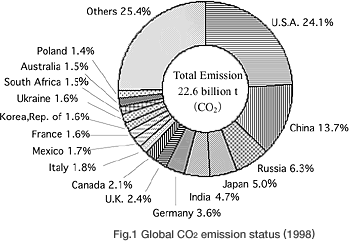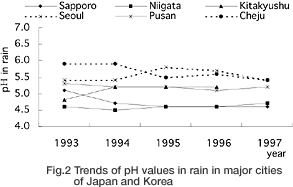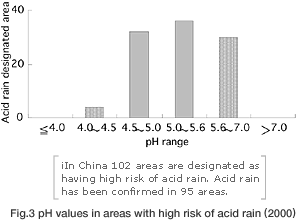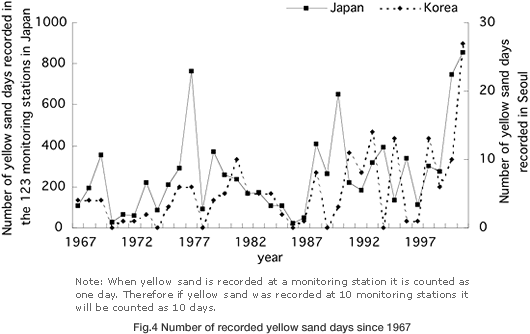|
 |
 |
As many of the environmental problems have now begun to expand on a global scale, it has become necessary to approach them from a global perspective beyond the boundaries of countries and regions.
This report will summarize the present status of the three environmental issues, global warming, acid rain and yellow sand, the effects of which are known to be spreading to the Northwest Pacific Region. |
 |
Global warming
 Vast amounts of green-house gases like carbon dioxide are discharged as a result of increasing human activities. As such the earth’s energy balance is altered and global warming is progressing rapidly. According to the third assessment report (2001) of the International Panel on Climate Change (IPCC), the average global air temperature is predicted to increase by 1.4-5.8ºC(from 1990 level) and sea level is predicted to rise by 9-88cm (from 1990 level) within this century. Vast amounts of green-house gases like carbon dioxide are discharged as a result of increasing human activities. As such the earth’s energy balance is altered and global warming is progressing rapidly. According to the third assessment report (2001) of the International Panel on Climate Change (IPCC), the average global air temperature is predicted to increase by 1.4-5.8ºC(from 1990 level) and sea level is predicted to rise by 9-88cm (from 1990 level) within this century.
Figure 1 shows the status of global CO2 emission. According to the above statistics, in 1998, China, Russia and Japan were the second, third and forth largest CO2 emitting nations in the world, respectively. The total CO2 emission of these 4 countries including Korea amounted to 27% of the world total of global CO2 emission. Table 1 shows the change of CO2 emission per capita on a country to country basis. |
 |
| Table 1 CO2 emission of Sea of Japan bordering nations per capita |
| Unit : CO2 emission / capita |
Country
|
1971
|
1980 |
1985 |
1990 |
1995 |
1997 |
1998 |
1999 |
Global
|
3.85 |
4.14 |
3.99 |
4.03 |
3.88 |
3.92 |
3.88 |
3.85 |
| China |
1.04 |
1.52 |
1.80 |
2.15 |
2.57 |
2.58 |
2.49 |
2.44 |
Russia
|
- |
- |
- |
- |
10.96 |
10.37 |
10.11 |
10.48 |
| Japan |
7.07 |
7.88 |
7.51 |
8.61 |
9.12 |
9.31 |
9.09 |
9.27 |
| Korea |
1.64 |
3.30 |
3.85 |
5.50 |
8.06 |
9.27 |
7.99 |
8.65 |
|
|
 |
Acid rain
Acid rain is defined as rain which contains nitric acid, sulfuric acid and has pH values of lower than 5.6. Acid rain is produced in the atmosphere as a result of the reaction of nitrogen and sulfur oxides which are emitted from vehicles and factories. Acid rain is known to have adverse impacts on the ecosystem through the acidification of land, water, and soil. Also, corrosion of valuable cultural heritages is enhanced by acid rain.
Recently, highly acidic rains with pH values of pH 4.5-5.0 have been recorded in Japan, China and Korea. This indicates that these values are at about the same level as those of Europe and the United State. These countries have suffered from damage caused by acid rain to forests, lakes and marshes. If such rain continues to fall, the impact may also be great in the Asia-Pacific region. |
 |
 |
 |
 |
Yellow sand
As spring approaches, the sky sometimes becomes hazy and turns into a yellowish color. This phenomenon is caused by the microscopic particles that float in the air column and are referred to as “yellow sand”. These particles fall and remain in and around the Taklimakan Desert and other desert regions near the Hexi Corridor and Loess Plateau located in inland China. During early spring, low pressure systems frequently develop in these regions and tiny sand particles are dispersed into the high atmosphere (5,000-10,000 m) and then is transported to distant locations by the prevalent westerly winds.
These microscopic particles have the properties to disperse or absorb sunlight, alter cloud structure and transport absorbed atmospheric pollutants to wide areas. Consequently these particles are considered to influence the climate and also induce respiratory illness. However, since these particles contain 1% of carbonate and attach to inorganic nutrients such as phosphate, calcium and iron, they display a neutralizing effect on acid rain and are also considered to be one of the nutrient sources for marine phytoplankton. Research on yellow sand is still in its infant stage and many aspects still remain to be solved. Thus further, more precise chemical analysis and evaluation of related information in respect to yellow sand is likely to be achieved.
Currently, the frequency and intensity of yellow sand events are known to have been increasing year by year in Japan and Korea. Air pollution by yellow sand is now emerging as a new environmental problem. |
 |
 |
 |
 |
|

